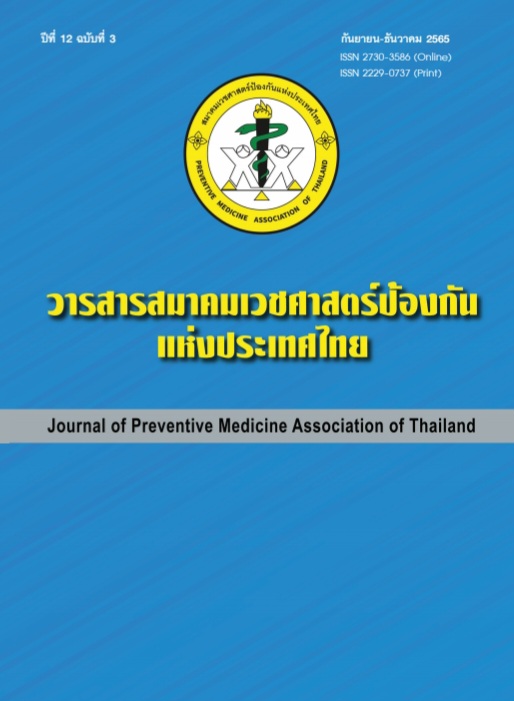COVID-19 Vaccine Side Effects in Children Aged 5-11 years in Thailand
Keywords:
adverse effects, COVID-19 vaccines, severityAbstract
This research was conducted with the objective to study the incidence of adverse outcomes from getting vaccines against Coronavirus 2019 (COVID-19) among children aged between 5 and 11 years with the method of a retrospective, cross-sectional study. The sample was from kindergarten 1 to elementary grade 6 students (along with their guardians) living in Thailand who received at least 1 dose of the vaccine regardless of the brand. The total number of participants was 1,232 people from the simple random sampling method of the schools-name list in Thailand. The data were collected from April to May 2022 via an online questionnaire as Google form, then were analyzed by both descriptive and inferential statistics with t-test and binary logistic regression to compare the incidence of side effects from COVID-19 vaccine between two age-group; of 5- to 8-year-old (kindergarten 1 to elementary grade 3) and 9- to 11-year-old (elementary grade 4 to 6). The result showed that there were 865 participants (70.21% of the total participants) reported at least 1 symptom of the side effects after vaccine administration within a month. The three most frequent reports of symptoms were local site pain (40.50%), myalgia (26.87%), and fatigue (12.42%). The older group suffered from adverse effects more than the younger one with the report of 563 people (71.99%) and 302 people (67.11%) respectively; however, the outcome showed no statistical difference significantly between these two groups in general (adjusted OR 1.26, 95%CI 0.96-1.64). The severity was more predominant among students who received the third dose than the first two doses. There was one patient admitted to a hospital with the diagnosis of myocarditis after COVID-19 vaccination; nevertheless, no fatal was reported for this study.
References
He X, Hong W, Pan X, Lu G, Wei X. SARS-CoV-2 Omicron variant: characteristics and prevention. Med Comm (2020) 2021;2(4):838-45
กรมควบคุมโรค. โรคติดเชื้อไวรัสโคโรนา 2019 (COVID-19) [อินเทอร์เน็ต]. 2563 [เข้าถึงเมื่อ 19 ม.ค. 2565]. เข้าถึงได้จาก: https://ddc.moph.go.th/viralpneumonia/situation.php
กรมควบคุมโรค. สถานการณ์เหตุการณ์ไม่พึงประสงค์หลังการได้รับวัคซีนป้องกันโรค COVID-19 [อินเทอร์เน็ต]. 2563 [เข้าถึงเมื่อ 19 ม.ค.2565]. เข้าถึงได้จาก: https://ddc.moph.go.th/viralpneumonia/situation.php
Sievertsen HH, Burgess S. Schools, skills, and learning: the impact of COVID-19 on education [Internet]. 2020 [cited 2022 Jan 18]. Available from: https://voxeu.org/article/impact-covid-19-education
Frenck RW Jr, Klein NP, Kitchin N, Gurtman A, Absalon J, Lockhart S, et al. Safety, immunogenicity, and efficacy of the BNT162b2 Covid-19 vaccine in adolescents. N Engl J Med 2021;385(3):239-50
Woodworth KR, Moulia D, Collins JP, Hadler SC, Jones JM, Reddy SC, et al. The advisory committee on immunization practices’ interim recommendation for use of Pfizer-BioNTech COVID-19 vaccine in children aged 5–11 years - United States, November 2021. MMWR Mord Mortal Wkly Rep 2021;70(45):1579-83.
Wu Z, Hu Y, Xu M, Chen Z, Yang W, Jiang Z, et al. Safety, tolerability, and immunogenicity of an inactivated SARS-CoV-2 vaccine (CoronaVac) in healthy adults aged 60 years and older: a randomised, double-blind, placebo-controlled, phase 1/2 clinical trial. Lancet Infect Dis 2021;21(6):803-12.
สำนักงานคณะกรรมการอาหารและยา. อย. อนุมัติวัคซีนไฟเซอร์ในกลุ่ม 5-11 ปี [อินเทอร์เน็ต]. 2564 [เข้าถึงเมื่อ 20 ธ.ค.2564]. เข้าถึงได้จาก: https://www.fda.moph.go.th/Pages/HomeP_D2.aspx
สำนักงานคณะกรรมการอาหารและยา. อย. อนุมัติวัคซีนซิโนแวคและซิโนฟาร์มในเด็ก 6 ปีขึ้นไป [อินเทอร์เน็ต]. 2564 [เข้าถึงเมื่อ 4 ก.พ.2565]. เข้าถึงได้จาก: https://www.fda.moph.go.th/Pages/HomeP_D2.aspx
Aguila MRD, Gonzalez-Ramirez A. Sample size calculation. Allergol Immunopathol (Madr) 2014;42(5):485-92.
Walter EB, Talaat KR, Sabharwal C, Gurtman A, Lockhart S, Paulsen GC, et al. Evaluation of the BNT162b2 Covid-19 vaccine in children 5 to 11 years of age. N Engl J Med 2022;386(1):35-46.
Berg SK, Wallach-Kildemoes HW, Rasmussen LR, Nygaard U, Bundgaard H, Petersen MNS, et al. Short and long term reported symptoms in adolescents aged 12-19 years after vaccination against SARS-CoV-2 compared to adolescents not vaccinated – a danish retrospective cohort study. Vaccines (Basel) 2022;10(11):1863.
World Health Organization. How do vaccine work? [Internet] 2020 [cited 2022 Dec 10]. Available from: https://www.who.int/news-room/feature-stories/detail/how-do-vaccines-work?gclid=Cj0KCQiA1sucBhDgARIsAFoytUuC_xEuswsXbJ2br-z4mxVQmwMtscvOXz685Tp8Nk25zMxKoyL2QU8aAuhfEALw_wcB
Lounis M, Rais MA, Bencherit D, Aouissi HA, Oudjedi A, Klugarova J, et al. Side effects of COVID-19 inactivated virus vs. adenoviral vector vaccines: experience of Algerian healthcare workers. Frontiers in Public Health 2022;10:896343.
Infectious Disease Advisor. COVID-19 mRNA vaccine lined to higher adverse event risk vs traditional vaccines [Internet]. 2022 [2022 Dec 10]. Available from: https://www.infectiousdiseaseadvisor.com/home/topics/covid19/safety-and-risks-of-covid-19-mrna-vaccines-compared-with-other-vaccines/
Oster ME, Shay DK, Su JR, Gee J, Creech CB, Broder KR, et al. Myocarditis case reported after mRNA-Based COVID-19 vaccination in the US From December 2020 to August 2021. JAMA 2022;327(4):331-40.
Downloads
Published
Versions
- 2023-01-17 (2)
- 2023-01-16 (1)
How to Cite
Issue
Section
License
Copyright (c) 2023 Journal of Preventive Medicine Association of Thailand

This work is licensed under a Creative Commons Attribution-NonCommercial-NoDerivatives 4.0 International License.
บทความที่ลงพิมพ์ในวารสารเวชศาสตร์ป้องกันแห่งประเทศไทย ถือเป็นผลงานวิชาการ งานวิจัย วิเคราะห์ วิจารณ์ เป็นความเห็นส่วนตัวของผู้นิพนธ์ กองบรรณาธิการไม่จำเป็นต้องเห็นด้วยเสมอไปและผู้นิพนธ์จะต้องรับผิดชอบต่อบทความของตนเอง






